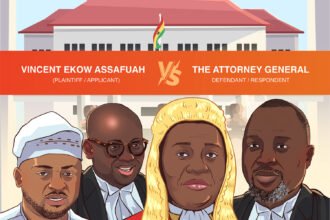
High Court · JELR 85230 · [1975] 2 GLR 31 · Ghana
Introduction
This case addresses the torts of assault and battery and the vicarious liability of the state for wrongful acts committed by its agents.
Facts:
Miller, a 16-year-old student, was shot in the head by Chief Superintendent C. O. Lamptey of the Ghana Police Service. Miller and a friend, Baba Sadiku, were attempting to sell a kente cloth- a legitimate gift from Miller’s father- around the Cantonments area. Lamptey, who initially declined to purchase the cloth, later suspected it was stolen and asked them to return it to his residence. When they ignored the message, he pursued them with two constables and fired two shots, one of which struck Miller in the head, causing catastrophic injury. The action was brought by Miller’s father, claiming damages against the Attorney-General on the Republic’s behalf for assault and battery by a public officer.
Holding:
The High Court found in favour of the plaintiff, holding that:
■ The court held that Lamptey’s use of force was intentional, excessive, and unjustified.
■ There were no reasonable grounds to suspect the boys of theft.
■ Even though Lamptey was a public officer, his conduct was not protected under lawful execution of duty.
■ The Republic was vicariously liable for his actions as an agent of the state.
■ Damages of ¢24,000 were awarded for pain, suffering, permanent disability, and diminished expectation of life.
Implications of the Decision:
This case affirmed the constitutional and legal limits of police powers in arresting suspected persons. It emphasized that suspicion alone is insufficient; reasonable grounds must exist prior to arrest. The court also clarified that excessive force, particularly one leading to grave harm, cannot be justified merely on grounds of duty.
The judgment is a pivotal reminder that state agents are not above the law and may be held civilly liable through the state for abuses of power.
Significant Quote:
“To shoot down a person in such a savage manner and in the circumstances such as this, under the guise of effecting that person’s arrest, is not only unreasonable but is also quite out of proportion of the occasion.”
“A police officer is not justified in shooting or in beating up any person merely because he wants to make an arrest. For the police officer to go to that extreme there must have existed a very dangerous situation created by the person intended to be arrested” – Abban J.
Commentary/Insight:
1. Police Accountability — The judgment reinforces that public officers must be held accountable for abuses, and state liability follows from their misconduct.
2. Constitutional Rights – It affirms the principle that citizens’ safety and dignity are not forfeited merely by suspicion.
3. Judicial Oversight – The case showcases the judiciary’s crucial role in checking executive power, especially when state violence is disguised as lawful action.
4. Modern Relevance – The ruling remains a powerful precedent for current debates around police brutality and rule of law.











